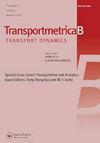Joint optimization of train scheduling and dynamic passenger flow control strategy with headway-dependent demand
IF 3.4
2区 工程技术
Q2 TRANSPORTATION
引用次数: 7
Abstract
Focusing on massive demand and high-frequency trains in urban rail transit, this paper proposes a novel joint optimization approach for train scheduling and dynamic passenger flow control strategy under oversaturated conditions to minimize the total number of waiting passengers. In view of the relationship between the number of boarding/alighting passengers and the dwell time of trains, the problem is formulated as a mixed-integer linear programming (MILP) model. This model can achieve the trade-off between the utilization of trains and passengers. The ILOG CPLEX is adopted to solve the proposed model. And a real-world case study of the Beijing Metro Line 5 is given to demonstrate the feasibility and effectiveness. Through jointly optimizing train schedule and flow control, the average boarding rate of passengers increases from 36.34% to 87.55%. The results show that the proposed flow control is effective in alleviating the oversaturated situations at platforms and trains.需求依赖的列车调度与动态客流控制策略联合优化
针对城市轨道交通中的海量需求和高频列车,提出了一种新的列车调度联合优化方法和过饱和条件下的动态客流控制策略,以最大限度地减少等待乘客总数。考虑到上下车乘客数量与列车停留时间之间的关系,将该问题公式化为混合整数线性规划(MILP)模型。该模型可以实现列车利用率和乘客利用率之间的权衡。采用ILOG CPLEX对所提出的模型进行求解。并以北京地铁5号线为例,验证了其可行性和有效性。通过联合优化列车时刻表和流量控制,乘客的平均上车率从36.34%提高到87.55%。结果表明,所提出的流量控制对缓解站台和列车的过饱和情况是有效的。
本文章由计算机程序翻译,如有差异,请以英文原文为准。
求助全文
约1分钟内获得全文
求助全文
来源期刊

Transportmetrica B-Transport Dynamics
TRANSPORTATION SCIENCE & TECHNOLOGY-
CiteScore
5.00
自引率
21.40%
发文量
53
期刊介绍:
Transportmetrica B is an international journal that aims to bring together contributions of advanced research in understanding and practical experience in handling the dynamic aspects of transport systems and behavior, and hence the sub-title is set as “Transport Dynamics”.
Transport dynamics can be considered from various scales and scopes ranging from dynamics in traffic flow, travel behavior (e.g. learning process), logistics, transport policy, to traffic control. Thus, the journal welcomes research papers that address transport dynamics from a broad perspective, ranging from theoretical studies to empirical analysis of transport systems or behavior based on actual data.
The scope of Transportmetrica B includes, but is not limited to, the following: dynamic traffic assignment, dynamic transit assignment, dynamic activity-based modeling, applications of system dynamics in transport planning, logistics planning and optimization, traffic flow analysis, dynamic programming in transport modeling and optimization, traffic control, land-use and transport dynamics, day-to-day learning process (model and behavioral studies), time-series analysis of transport data and demand, traffic emission modeling, time-dependent transport policy analysis, transportation network reliability and vulnerability, simulation of traffic system and travel behavior, longitudinal analysis of traveler behavior, etc.
 求助内容:
求助内容: 应助结果提醒方式:
应助结果提醒方式:


